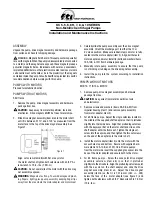
Arm, trigger, sync and ramp
Advanced Features
Output settle
In this SYNC generation mode, a SYNC is produced when the output of the Power
Module settles to within 2% of Vmax or Imax from the programmed Vset or Iset. A new
SYNC signal is generated following any commanded change of the Power Module’s
output, be it a new Vset or Iset value, a ramp operation or an output on/off state change.
You can use the SYNC signal to synchronize external hardware to changes in the Power
Module’s output.
To select this SYNC generation mode, use the following command:
SYNC <ch>,0
Trigger received
In this SYNC generation mode, the Power Module generates a SYNC whenever it
receives a trigger (either hardware or software trigger).
Using this SYNC generation mode enables the XMP 2600 to generate a hardware signal
in response to a software command.
To select this SYNC generation mode, use the following command:
SYNC <ch>,1
New output setting value
In this SYNC generation mode the Power Module generates a SYNC whenever a new
Vset or Iset value is programmed (and NOT when the output actually changes).
You can use the SYNC signal to synchronize external hardware to expected changes in
the Power Module’s output (an advanced trigger or “pre-trigger”).
To select this SYNC generation mode, use the following command:
SYNC <ch>,1
No SYNC generation
Select this SYNC generation mode when you do not want a Power Module to generate a
SYNC signal.
To select this SYNC generation mode, use the following command:
SYNC <ch>,3
Output
ramping
The following sections describe the output ramping feature of the XMP 2600 and give
usage guidelines.
What is output ramping?
Output ramping is a feature of the XMP’s Power Modules that enable them to produce a
gradual linear smooth change in their output. The change in a Power Module’s output can
be either a voltage change or a current change.
A ramp can be either a down-ramp (negative slope) or an up-ramp (positive slope) but it
cannot change the polarity of the Power Module’s output. To produce a ramp that crosses
zero (part positive and part negative) you will need to create two separate ramp
operations with a polarity changing command between them. Use the “sequential
operations” process described in the Synchronization of Operations section to make the
combined ramp as uniform as possible.
Output ramping can be as fast as a single output step occurring within 6mS of initiation
(limited by the module’s rise/fall time) or it can be a gradual process lasting as long as 6
Minutes, 33 Seconds and 210 mili-seconds.
28
XMP 2600 Programming Manual
rev. 1.1
















































